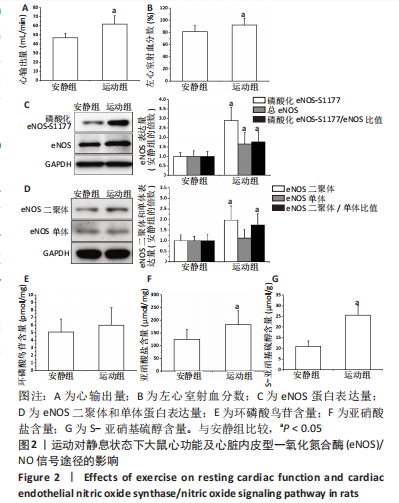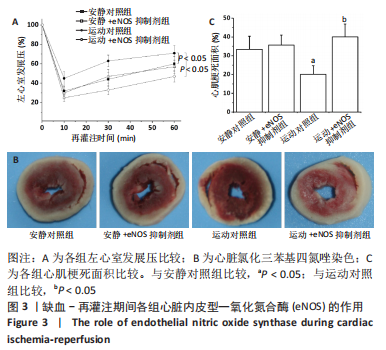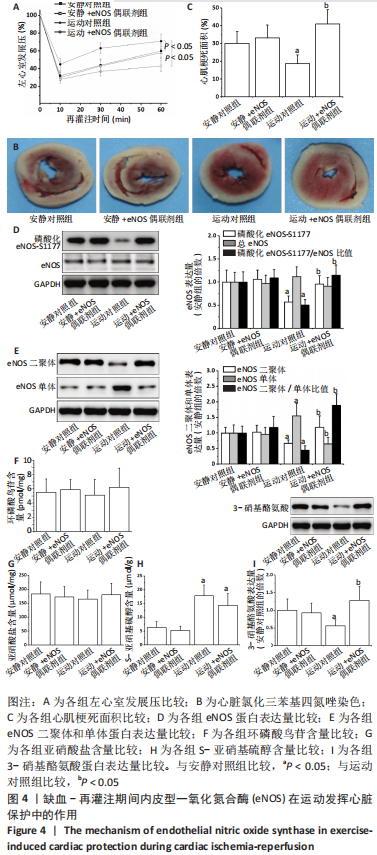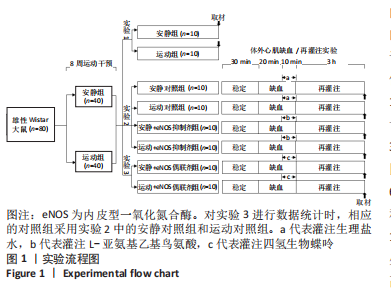中国组织工程研究 ›› 2024, Vol. 28 ›› Issue (8): 1283-1288.doi: 10.12307/2023.993
• 组织构建细胞学实验 cytology experiments in tissue construction • 上一篇 下一篇
内皮型一氧化氮合酶在运动预适应改善心肌缺血-再灌注损伤中的作用
娄 国1,张 艳2,付常喜3
- 1江苏经贸职业技术学院,江苏省南京市 211168;2广西中医药大学,广西壮族自治区南宁市 530021;3 徐州工程学院体育学院,江苏省徐州市 221008
Role of endothelial nitric oxide synthase in exercise preconditioning-induced improvement of myocardial ischemia-reperfusion injury
Lou Guo1, Zhang Yan2, Fu Changxi3
- 1Jiangsu Vocational Institute of Commerce, Nanjing 211168, Jiangsu Province, China; 2Guangxi University of Chinese Medicine, Nanning 530021, Guangxi Zhuang Autonomous Region, China; 3School of Physical Education, Xuzhou Institute of Technology, Xuzhou 221008, Jiangsu Province, China
摘要:
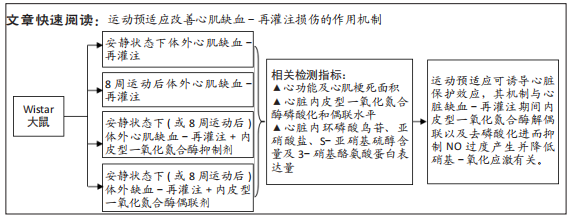
文题释义:
运动预适应:反复运动刺激诱导机体产生适应性变化,机体对于随后的不良应激源(如缺血-再灌注)耐受性增强,称为运动预适应,这是运动促进健康、预防疾病的重要机制。内皮型一氧化氮合酶解偶联:内皮型一氧化氮合酶是一种同源二聚体酶(偶联),在生理条件下催化L-精氨酸合成一氧化氮。当二聚体结构解离为单体时称为解偶联,此时催化的生化反应发生变异,其产物为超氧阴离子而非一氧化氮。
背景:运动是防治各种心血管疾病并保护心脏免受缺血-再灌注损伤的有效策略,其作用机制有待深入研究。
目的:观察有氧运动预适应对心肌缺血-再灌注损伤的影响,并探讨内皮型一氧化氮合酶(endothelial nitric oxide synthase,eNOS)激活(包括偶联和磷酸化)在其间的作用。方法:取80只成年Wistar大鼠,采用随机数字表法分为安静组(n=40)和运动组(n=40),运动组进行8周有氧运动,安静组在鼠笼内安静饲养。8周后进行3项实验:①实验1:末次训练后,检测大鼠心功能、心脏NO代谢物含量及心脏eNOS、磷酸化eNOS-S1177、eNOS二聚体、eNOS单体的蛋白表达量;②实验2:将大鼠分为安静对照组、运动对照组、安静+eNOS抑制剂组、运动+eNOS抑制剂组,均进行体外心肌缺血-再灌注损伤实验,安静+eNOS抑制剂组、运动+eNOS抑制剂组再灌注前10 min持续灌注eNOS抑制剂,再灌注3 h后检测心功能与心肌梗死面积;③实验3:将大鼠分为安静对照组、运动对照组、安静+eNOS偶联剂组和运动+eNOS偶联剂组,均进行体外心肌缺血-再灌注损伤实验,安静+eNOS偶联剂组和运动+eNOS偶联剂组再灌注前10 min持续灌注eNOS偶联剂,再灌注3 h后检测心肌梗死面积、心脏NO代谢物含量及心脏eNOS、磷酸化eNOS-S1177、eNOS二聚体、eNOS单体和3-硝基酪氨酸的蛋白表达量(其中,磷酸化eNOS-S1177/eNOS比值反映eNOS磷酸化/去磷酸化水平,eNOS二聚体/单体比值反映eNOS偶联/解偶联水平)。
结果与结论:①实验1:与安静组比较,运动组大鼠心输出量、左心室射血分数升高(P < 0.05),亚硝酸盐和S-亚硝基硫醇含量升高(P < 0.05),磷酸化eNOS-S1177、eNOS蛋白表达和磷酸化eNOS-S1177/eNOS比值上调(P < 0.05),eNOS二聚体蛋白表达和eNOS二聚体/单体比值升高(P < 0.05);②实验2:与安静对照组比较,运动对照组左心室发展压升高(P < 0.05),心肌梗死面积下降(P < 0.05);与运动对照组比较,运动+eNOS抑制剂组左心室发展压降低(P < 0.05),心肌梗死面积增加(P < 0.05);③实验3:与安静对照组比较,运动对照组左心室发展压升高(P < 0.05),心肌梗死面积下降(P < 0.05),磷酸化eNOS-S1177/eNOS比值下降(P < 0.05),eNOS二聚体/单体比值下降(P < 0.05),S-亚硝基硫醇含量增加(P < 0.05),3-硝基酪氨酸蛋白表达量下调(P < 0.05);与运动对照组比较,运动+eNOS偶联剂组左心室发展压降低(P < 0.05),心肌梗死面积增加(P < 0.05),磷酸化eNOS-S1177/eNOS比值升高(P < 0.05),eNOS二聚体/单体比值升高(P < 0.05),3-硝基酪氨酸蛋白表达升高(P < 0.05);④结果表明:有氧运动预适应可诱导心脏保护效应,其机制与心脏缺血-再灌注期间eNOS解偶联以及去磷酸化进而抑制NO过度产生并降低硝基-氧化应激有关。
https://orcid.org/0000-0002-4369-0174(娄国)
中国组织工程研究杂志出版内容重点:组织构建;骨细胞;软骨细胞;细胞培养;成纤维细胞;血管内皮细胞;骨质疏松;组织工程
中图分类号:
